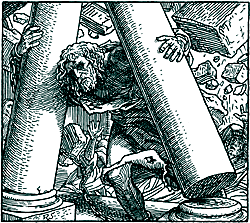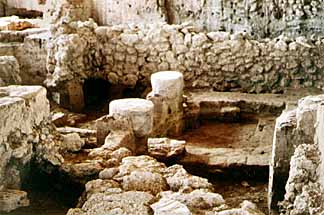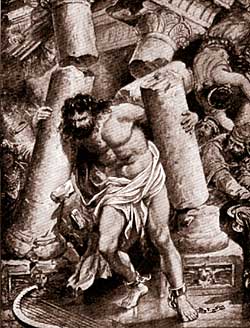Does archaeology shed any light on the story of Samson pulling down a Philistine temple?
In the story of Samson it says he pulled down an entire temple. Have archaeologists uncovered any information that would relate to this account?
A major turning point in Israel’s war against the Philistines was Samson’s death. He had been taken captive through the deception of Delilah. The Philistines gouged out his eyes and took him to Gaza, one of their main cities.
There they put him to work grinding grain in a prison. We know from archaeological findings that this type of prison was in reality a “grinding house.” One of the most time-consuming tasks in antiquity was the grinding of grain. In the average home, this fell to the women of the household. The bureaucratic aristocracy, however, set up grinding houses to provide grain for the privileged elite. This was a place where slaves and prisoners were put to work. The tools were simple hand grinding stones.
Samson spent his days seated on the ground grinding grain with a hand-held pestle that was rubbed back and forth on a mortar in his lap.
One day the Philistine leaders held a religious ceremony to celebrate their victory over their enemy. They brought Samson into the temple where they were assembled, so he could entertain them. Once inside the temple, Samson asked the servant who was guiding him to show him where the pillars were, so he could lean against them. “Then Samson reached toward the two central pillars on which the temple stood. Bracing himself against them, his right hand on the one and his left hand on the other, Samson said, ‘Let me die with the Philistines!’ Then he pushed with all his might, and down came the temple on the rulers and all the people in it. Thus he killed many more when he died than while he lived” (Judges 16:29-30).
In one fell swoop, Samson eliminated the entire Philistine leadership. This was a major setback in their conflict with Israel. It was a turning point. From this time on, the Israelites started to gain the upper hand.
But did it really happen? Could one man pull down an entire temple single handed? Archaeology has provided us with some amazing answers.
Two Philistine temples have been uncovered by archaeologists. One at Tel Qasile, in northern Tel Aviv, and one in Tel Miqne, ancient Ekron, 21 miles south of Tel Aviv. Both temples share a unique design—the roof was supported by two central pillars! The pillars were made of wood and rested on stone support bases. With the pillars being about six feet apart, a strong man could dislodge them from their stone bases and bring the entire roof crashing down. The archaeological findings match the Biblical story perfectly and attest to the plausibility of the account.
Although Samson had his weaknesses, he was a man of God and is listed in the New Testament as one of those “who through faith conquered kingdoms, … whose weakness was turned to strength” (Hebrews 11:32-34).
Author: Bryant G. Wood Ph.D. of Associates for Biblical Research
Between the Pillars: Revisiting “Samson and the House of Dagon”
The Biblical tableau of Samson’s death in the house of the Philistine god Dagon in Gaza is familiar to the scholar and the casual reader of the Bible alike. The components of the scene are the Philistine crowd cheering at the capture of Samson, the proud Philistine lords who have come to witness the death of their enemy, and a blinded and battered Samson standing between the main pillars of the temple. In the midst of this chaotic scene Samson utters a prayer to YHWH to be remembered and strengthened so to avenge himself upon his enemies. Knowing full well that this last stand against the Philistines will cost him his life, Samson dislodges the pillars, thereby collapsing the temple upon all who were in it (Judges 16:23–30).
The State of the Question
The historicity of this heroic account has been long debated among scholars. Indeed, many scholars seem hesitant to comment on the historicity of the Samson narratives at all. From the scholarly debate over the destruction of the Gaza temple two diametrically opposed viewpoints have emerged. John L. McKenzie typifies the first viewpoint. Always a detractor of Samson, McKenzie argues that:
the historical quality of heroic tales is always low. This is easy to see in Samson. A palace or temple which could support several thousand people on its roof supported by two central pillars separated by an arm’s length never existed… The world in which Samson lives is real, even if his feats of strength are not (1979: 229–30).
In other words, McKenzie sees the stories of Samson’s immense power as highly exaggerated popular tales. These tales were circulated during the time of Philistine domination of Israel during the settlement period of Israel. The stories of the strength of Samson were meant to have been a source of religious hope for Israel and to bolster their waning national spirit.
On the other hand, Dr. Bryant G. Wood advocates an opposing theory. He points out that during a 1972 excavation the first Philistine temple ever to be found was brought to light at Tell Qasile, on the north side of Tell Aviv. This temple is comprised of an antechamber and main hall. According to Wood, “this hall, with inside measurements of 18½ feet by 23½ feet, is a room whose roof was originally supported by two wooden pillars set on round, well-made stone bases, placed along a center axis” (1974: 51).
Although the Gaza temple of Dagon has yet to be excavated, because a modern city sits on top of it, Wood suggests that the Gaza temple “must have been very similar to the one at Tell Qasile.” The Biblical text describes the Gaza temple as having two pillars supporting the roof (Judges 16:24). He concludes, “the Bible writer knew his facts. He knew that Philistine temples were supported by two pillars and that this was how Samson pulled the temple down. The report is that of an eye-witness, again demonstrating that indeed the Bible is the world’s most accurate history textbook” (1974: 54).
Overall, the debate over the historicity of Samson in the Gaza temple spans a wide spectrum of positions. Prominent scholars are on both sides of the historicity issue. Therefore, in this study we are going to look at the linguistic evidence in the Hebrew text to try to determine which side of the debate the narrative validates. In other words, we are trying to determine whether the story of Samson between the pillars of Dagon is only an exaggerated reflection of a historical event written to satisfy the agendas of storytellers and later Biblical authors, or if this text can be seen as an actual historical account of the last stand of Samson against the Philistines.
The Linguistic Evidence
The Hebrew text is very clear in its description of the actions of Samson. The text reads that Samson grasped the two middle pillars that supported the house of the temple, ‘ehād kîmînô we‘ehād biśmō‘lô (one with his right hand and one with his left). The pillar bases at Tell Qasile are about 2 meters (7 feet) apart, well within the reach of a tall man. Therefore, the first part of the description of Samson’s death is consistent with the excavated temple.
The text then reads that Samson “bent powerfully” in his effort to dislodge the pillars. The Hebrew term nātāh (bend), while a common word, contains connotations of bending under a force or effort. Issachar bends his shoulder to the burden (Genesis 49:15). A wadi, riverbed, is said to bend or slope (Numbers 21:15).
The word used in conjunction with the term “bend” is bekōha, literally “in strength.” The assumed root of the term is khh, meaning “the capacity to act.” The term is an expression of potency and refers to the subject’s capacity to produce. Moreover, the usual intent is to denote physical strength (Oswalt 1980: 436–37).
It is noteworthy that the term khh occurs eight times in the book of Judges, with seven of the occurrences in chapter 16 (verses 5, 6, 9, 15, 17, 19, 30). While this term denotes the ability to do something, often the “emphasis is on the lack of strength or the insufficiency of human strength in comparison to God.” One must observe that the first five occurrences in chapter 16 deal with Delilah looking for the secret of Samson’s strength in order to render Samson helpless, and the sixth occurs with the loss of his strength after she cut his hair. The final occurrence, between the pillars, comes immediately following Samson’s petition to the Lord for power. Herein Samson does not rely only upon his natural strength, but that which comes from God. This usage of the term seems to parallel that which is found in the Psalter. In the Psalter the term occurs in “isolated individual laments with reference to dissipated human might that occasions the pious to pray for God’s assistance” (Psalm 22:16; 31:11; 38:11; 71:9, and 102:24) (Van der Woude 1997: 610–11).
The combination of these two terms denotes a powerful movement on the part of Samson. Such a surge of power would be consistent with the effort needed to dislodge the pillars from their bases, as they were held in place by the weight of the temple. Once the pillars were in motion Samson would have to continue dragging them off their bases.
We then read that the temple fell upon the Philistine lords and onlookers. The Hebrew term nāpal (fall), occurs in the text. It has been argued that “besides the common physical action or occurrence [of falling], a violent or accidental circumstance is often indicated… damage, death, or destruction are often designated” (Fisher 1980: 587). Clearly this act was not an accident, but a violent surge of power such as alluded to above. Possibly a better rendering of the term would be “fall in/collapse.” If Samson dragged the pillars off their bases, the roof would collapse upon the Philistine lords. Once the main hall of the temple collapsed, the rest of the structure, being extremely unstable from the weight of the people and having its main supports lost, would collapse as well. Therefore, the narrative is perfectly consistent with the findings at Tell Qasile.
How Many People?
One should observe that the text notes that Samson killed more people at his death than he did during his lifetime (Judges 16:30). The text states that the temple was full of men and women; the Philistine lords were present and about 3,000 people looked on from the roof (Judges 16:27). The validity of this description has been challenged by many scholars, most notably McKenzie. Admittedly, the temple at Tell Qasile does not substantiate this type of number as the building measures only 26 feet (8 meters) in width and 47 feet (14.5 meters) in length.
This seems to indicate that the understanding of the number of people in attendance must be redefined. The Hebrew term ‘elep represents the numeral 1,000. However, there are several specialized meanings attached to this term. One meaning is that the term represents the “largest basic division of leadership in political oversight or military leadership.” Also, “it is occasionally alleged that since ‘elep means a company of a thousand men it could mean any military unit, even of reduced strength” (Scott 1980: 48). Therefore, it seems as though the text is referring to three distinct contingencies that were in attendance, in addition to the followers of Dagon who filled the temple.
It is difficult to determine from where these contingencies came. However, Judges 1:18–19 may contain a clue. While the Philistines eventually established a pentapolis in Canaan, only the Philistine cities of Gaza, Ashkelon, and Ekron are noted. According to the Samson narratives, these cities are the exact areas of Samson’s exchanges with the Philistines. This may suggest that the tribal traditions of Judges 1:18 and the Samson narratives originated before the cities of Gath and Ashdod were incorporated into the Pentapolis. Consequently, the lords of Gaza, Ashkelon, and Ekron would be all of the lords of the Philistines, to which the text refers (Judges 16:27). This agreement between Judges 1 and the Samson narratives indicates the antiquity of the Samson traditions. Moreover, the fact that three, not five, groups are noted suggests that the death cycle of Samson originated either from an actual eye-witness to the events or a time in close proximity to the events, before the five names contained in the Philistine pentapolis became formulaic.
Conclusions
There are three main conclusions that can be drawn from this revisiting of the temple issue. First, it is clear that the linguistic evidence supports the side of the debate that sees the temple scene as historical, as typified by Dr. Bryant Wood. Scholars such as J.L. McKenzie, who reject any historical components in the Samson narratives, tend to follow the line of thought that presumes that the Samson narratives originated as a profane folk tale. Furthermore, the religious elements in the narratives are seen as additions or insertions that were placed in the account in order to make Samson more acceptable to Yahwism. Archaeological discoveries, such as those at Tell Qasile, are beginning to call such sweeping presuppositions into question.
Secondly, it seems very likely that the story of the destruction of the Gaza temple was originated by an actual eyewitness or a narrator who lived in close proximity with the events. The Hebrew terms that constitute the key actions (Samson BENT POWERFULLY AND THE TEMPLE FELL…) all contain connotations of violent power. Moreover, the actions that are described are completely consistent with the findings at Tell Qasile. According to the excavated findings, the wooden pillars were held in place by the weight of the temple. To dislodge and set the pillars in motion would demand an immense surge of power. The term denoting the collapsing of the temple complements this description, as it is used in reference to the result of a violent act that brings about damage, destruction, and death. Therefore, these should be seen as complementary terms that are validated by the archaeological findings at Tell Qasile.
Thirdly, the combination of the findings at Tell Qasile and the specific wording of the text describing Samson’s final act validates the historicity of the temple tradition, if not the entire set of Samson narratives. The destruction of the temple at Tell Qasile has been dated to the early tenth century BC. Such a dating is consistent with the rise and fall of Philistine power, as they had a period of ascendancy before the monarchy and were defeated by David in the late 11th century BC. After this defeat the Philistines were no longer a powerful force in this region. Only one who lived in the time of the Judges or the early monarchy could have been familiar with the structure of Philistine temples. Defining the period of Philistine power as the era from the settlement to the early monarchy (ca. 1200–1000 BC) also helps to define the time period in which Samson lived. Because this temple account seems to have been generated by an eyewitness to the event, Samson could not have been the creation of storytellers or later Biblical authors. Therefore, it suggests that McKenzie’s assessment was in error. The world in which Samson lived was real and so was his strength.
Author: John Roskoski Ph.D., ABR Associate
More information
Bryant G. Wood, “Samson and the House of Dagon,” Bible and Spade, (1974) pp. 50-54. (available from the Associates for Biblical Research).
Samson (Christian Answers Encyclopedia)
Philistines (Christian Answers Encyclopedia)
Copyright © 1995, 2008, Associates for Biblical Research, All Rights Reserved—except as noted on attached “Usage and Copyright” page that grants ChristianAnswers.Net users generous rights for putting this page to work in their homes, personal witnessing, churches and schools.




